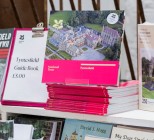Bryson visits a number of museums and historic sites in his meanderings through the United Kingdom. In his signature fashion pairing humour with knowledge and stories, Bryson honestly tells us what he thinks of each place he visits. This is very useful for museums, visitor research without having to ask anyone or employ anybody. Yes, he is just one visitor but he is such a thoughtful visitor who shares his views in depth.
We can learn from such a considered report, so I’ve pulled out five lessons from Bryson’s observations on a few of the museums he visits. Each lesson has wider application for our own endeavours where ever we are.
1.Interest + Price = Good Value
The visitor likes good value and its even better when that good value comes with something worth seeing. One of the first places Bryson visits is Leighton House, London. He likes it ‘…immediately, not least because my ticket price was reduced…on account of my great age.’ Bryson describes the former home and studio of artist Frederic Leighton as ‘…interestingly eccentric…’ and ‘… a cross between a pasha’s den and a New Orleans bordello…’. (The Road to Little Dribbling, page 53)
2.Try not to stand in the way of the experience
Bryson visits Avebury, National Trust owned village and World Heritage listed Neolithic site, which he describes as ‘…both awesome and entrancing…’. But he only awards these words to the site after a detailed description of all the blocks that get in the way of the experience. There is very little signage or interpretative information. If you want information, you have to buy it as a map or guidebook. This is in addition to the entry fees to the different parts of the site. I suspect Bryson may not have been ‘…so slightly grumpy …’ if the ticket price was more inclusive and included some package of items, rather than having to pay separately for each bit. (The Road to Little Dribbling, pages 134-136)
3.Museums aren’t shopping malls
His visit to the Natural History Museum in London captures so many of the issues facing museums and galleries today. The need to be more financially viable competes with the more traditional magic we have offered for centuries. Bryson is deeply, deeply unhappy with the changes at the Natural History Museum, including the replacement of the animal displays he loved with food for sale. Bryson says ‘Slowly it dawned on me what is going on here. The Natural History Museum can’t afford to be a museum anymore, so the directors are stealthily turning it into a food court.’ He does have words of praise for the exhibition he came to see which ‘…was everything an exhibition should be, thoughtful, informative, engaging, soothingly lit, blissfully quiet’ and full of objects which had never been brought together before in meaningful ways.
It’s always nice to have your own opinions validated by others but I do think Bryson is on to something here. Museums shouldn’t try to be a shopping centre, for a start we don’t have the budget or the staff to compete, and it’s also not what we are good at. Gift shops and cafes have their place, but that’s not why we exist. (The Road to Little Dribbling, pages 194-195)
4.Creating (useful) enchantment
Which leads me onto two other museums Bryson visits, this time the Natural History Museum and the Pitt Rivers Museum in Oxford. This place achieves what we all, I suspect, hope to achieve: to be so interesting and enticing that the visitor can’t help but stay. Bryson says ‘I only intended to have a quick look around both museums, but stayed for nearly three hours and still hadn’t seen half of what I wanted to see. It wasn’t just that both are endlessly interesting, but that they are actually useful.’ Now, I’m sure many will argue that museums are more than just places of learning but if your visitors left a similar comment you would be delighted. ‘I have never learned so much so quickly and so painlessly…for a minute I knew and was enchanted.’ (The Road to Little Dribbling, page 235)
5.The power of good storytelling
Still in Oxford, Bryson moves onto the Ashmolean, for which he has nothing but praise describing ‘every room’ as a place of ‘…wonderful things exquisitely displayed…’. With its focus on art and archaeology, Bryson notes that he has no particular interest in statues but that he was pulled into the story, a story well told, of the statues, ‘…but the story of assembling and near loss of the collection, told in a series of panels, is so absorbing that I found myself reading each and then studying the statues in between. And the next thing I knew an hour was gone.’ (The Road to Little Dribbling, page 238)
I have, at different times and places, stood in museums and watched how long visitors stand and watch a film, read a label or engage with an object. And its not very long, so for Bill Bryson to be so attracted to a story, about a subject he didn’t have a particular interest in, is testament to why museums still exist today. We tell stories of meaning. We tell stories that help us understand our world. We tell stories that matter. Shopping malls don’t do that.











